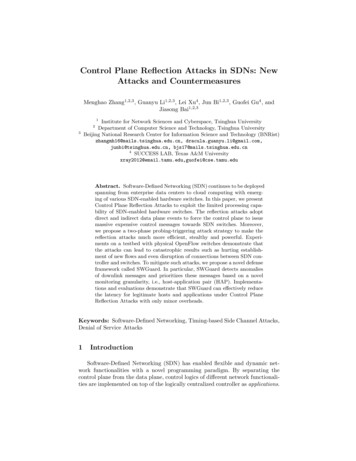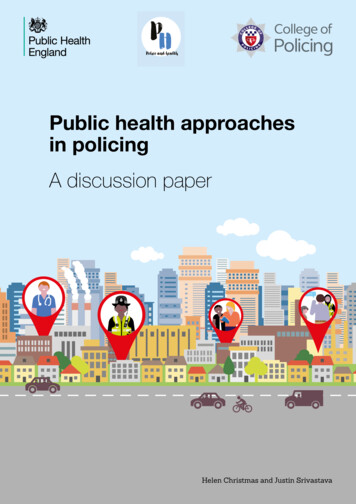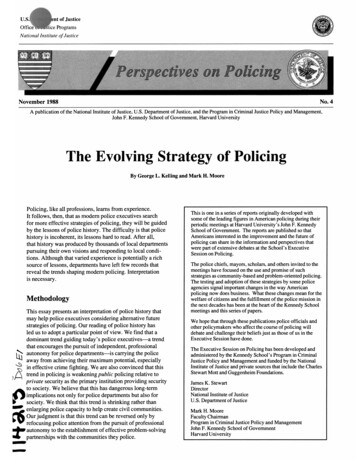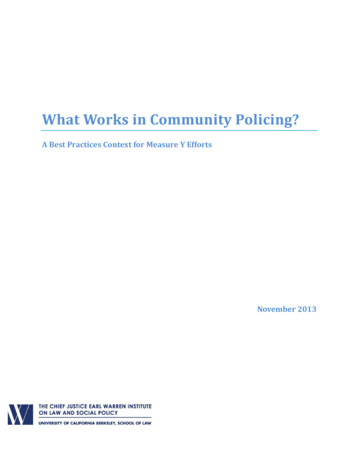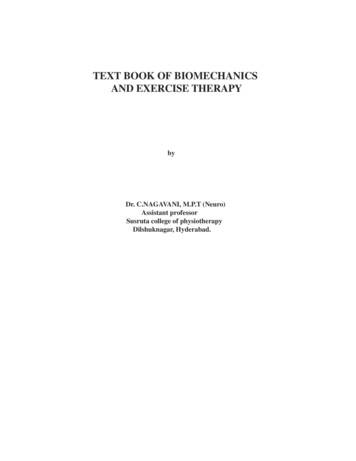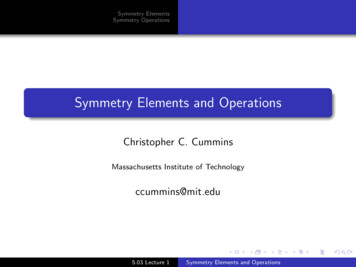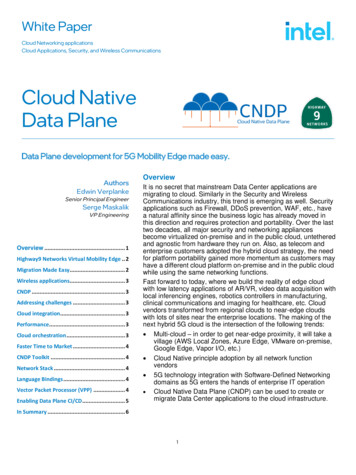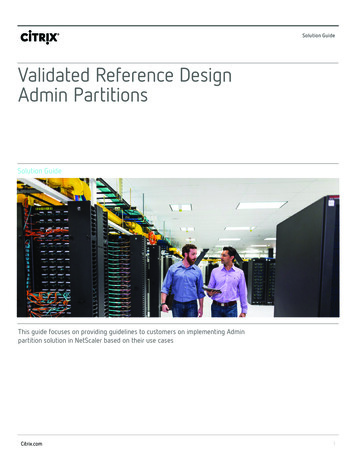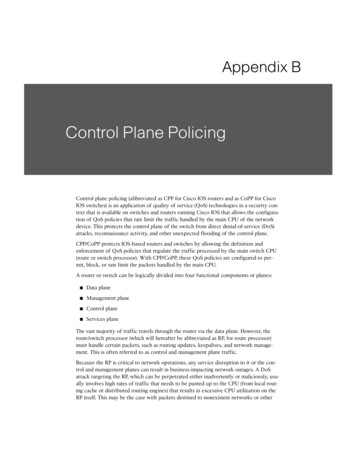
Transcription
Appendix BControl Plane PolicingControl plane policing (abbreviated as CPP for Cisco IOS routers and as CoPP for CiscoIOS switches) is an application of quality of service (QoS) technologies in a security context that is available on switches and routers running Cisco IOS that allows the configuration of QoS policies that rate limit the traffic handled by the main CPU of the networkdevice. This protects the control plane of the switch from direct denial-of-service (DoS)attacks, reconnaissance activity, and other unexpected flooding of the control plane.CPP/CoPP protects IOS-based routers and switches by allowing the definition andenforcement of QoS policies that regulate the traffic processed by the main switch CPU(route or switch processor). With CPP/CoPP, these QoS policies are configured to permit, block, or rate limit the packets handled by the main CPU.A router or switch can be logically divided into four functional components or planes: Data plane Management plane Control plane Services planeThe vast majority of traffic travels through the router via the data plane. However, theroute/switch processor (which will hereafter be abbreviated as RP, for route processor)must handle certain packets, such as routing updates, keepalives, and network management. This is often referred to as control and management plane traffic.Because the RP is critical to network operations, any service disruption to it or the control and management planes can result in business-impacting network outages. A DoSattack targeting the RP, which can be perpetrated either inadvertently or maliciously, usually involves high rates of traffic that needs to be punted up to the CPU (from local routing cache or distributed routing engines) that results in excessive CPU utilization on theRP itself. This may be the case with packets destined to nonexistent networks or other042 9781587143694 app02.indd 110/30/13 9:29 PM
2End-to-End QoS Network Designrouting failures. This type of attack, which can be devastating to network stability andavailability, may display the following symptoms: High route processor CPU utilization (near 100 percent). Loss of line protocol keepalives and routing protocol updates, leading to route flapsand major network transitions. Interactive sessions via the command-line interface (CLI) are slow or completelyunresponsive due to high CPU utilization. RP resource exhaustion, meaning that resources such as memory and buffers areunavailable for legitimate IP data packets. Packet queue backup, which leads to indiscriminate drops (or drops due to lack ofbuffer resources) of other incoming packets.CPP/CoPP addresses the need to protect the control and management planes, ensuringrouting stability, availability, and packet delivery. It uses a dedicated control plane configuration via the Modular QoS command-line interface (MQC) to provide filtering andrate limiting capabilities for control plane packets.Packets handled by the main CPU, referred to as control plane traffic, typically includethe following: Routing protocols. Packets destined to the local IP address of the router. Packets from network management protocols, such as Simple Network ManagementProtocol (SNMP). Interactive access protocols, such as Secure Shell (SSH) and Telnet. Other protocols, such as Internet Control Message Protocol (ICMP), or IP options,might also require handling by the switch CPU. Layer 2 packets such as bridge protocol data unit (BPDU), Cisco Discovery Protocol(CDP), DOT1X, and so on. Layer 3 protocols such as authentication, authorization, and accounting (AAA),syslog, Network Time Protocol (NTP), Internet Security Association and KeyManagement Protocol (ISAKMP), Resource Reservation Protocol (RSVP), and so on.CPP/CoPP leverages the MQC for its QoS policy configuration. MQC allows the classification of traffic into classes and lets you define and apply distinct QoS policies toseparately rate limit the traffic in each class. MQC lets you divide the traffic destined tothe CPU into multiple classes based on different criteria. For example, four traffic classescould be defined based on relative importance: Critical Normal042 9781587143694 app02.indd 210/30/13 9:29 PM
Appendix B: Control Plane Policing Undesirable Default3After you define the traffic classes, you can define and enforce a QoS policy for eachclass according to importance. The QoS policies in each class can be configured to permit all packets, drop all packets, or drop only those packets exceeding a specific ratelimit.Note The number of control plane classes is not limited to four, but should be chosenbased on local network requirements, security policies, and a thorough analysis of thebaseline traffic.Note It is also important to keep in mind that CoPP/CPP does not protect the switch/router against itself. For example, in some situations SNMP traps or NetFlow exportsgenerated by the device may be excessive and could have detrimental effects on the CPU,the same way a DoS attack might. Therefore, it is beneficial for an administrator to keepthis caveat in mind when deploying such management policies.Defining Control Plane Policing Traffic ClassesDeveloping a CPP policy starts with the classification of the control plane traffic. To thatend, the control plane traffic needs to be first identified and separated into different classmaps.This section presents a classification template that can be used as a model when implementing CPP on IOS routers in addition to when deploying CoPP on Cisco Catalystswitches. This template presents a realistic classification, where traffic is grouped basedon its relative importance and protocol type. The template uses eight different classes,which provide a high level of granularity and make it suitable for real-world environments.Note Even though you can use this template as a reference, the actual number and typeof classes needed for a given network can differ and should be selected based on localrequirements, security policies, and a thorough analysis of baseline traffic.This CPP/CoPP template defines these eight traffic classes: 042 9781587143694 app02.indd 3Border Gateway Protocol (BGP): This class defines traffic that is crucial to maintaining neighbor relationships for BGP routing protocol, such as BGP keepalives androuting updates. Maintaining BGP routing protocol is crucial to maintaining con-10/30/13 9:29 PM
4End-to-End QoS Network Designnectivity within a network or to an Internet service provider (ISP). Sites that are notrunning BGP would not use this class. Interior Gateway Protocol (IGP): This class defines traffic that is crucial to maintaining IGP routing protocols, such as Open Shortest Path First (OSPF), EnhancedInterior Gateway Routing Protocol (EIGRP), and Routing Information Protocol (RIP).Maintaining IGP routing protocols is crucial to maintaining connectivity within anetwork. Interactive Management: This class defines interactive traffic that is required forday-to-day network operations. This class would include light volume traffic used forremote network access and management. For example, Telnet, SSH, NTP, SNMP, andTerminal Access Controller Access Control System (TACACS). File Management: This class defines high-volume traffic used for software image andconfiguration maintenance. This class would include traffic generated for remote filetransfer; for example, Trivial File Transfer Protocol (TFTP) and File Transfer Protocol(FTP). Monitoring/Reporting: This class defines traffic used for monitoring a router. Thiskind of traffic should be permitted but should never be allowed to pose a risk tothe router. With CPP/CoPP, this traffic can be permitted but limited to a low rate.Examples include packets generated by ICMP echo requests (ping and traceroute) inaddition to traffic generated by Cisco IOS IP Service Level Agreements (IP SLAs) togenerate ICMP with different differentiated services code point (DSCP) settings toreport on response times within different QoS data classes. Critical Applications: This class defines application traffic that is crucial to a specific network. The protocols that might be included in this class include genericrouting encapsulation (GRE), Hot Standby Router Protocol (HSRP), Virtual RouterRedundancy Protocol (VRRP), Gateway Load Balancing Protocol (GLBP), SessionInitiation Protocol (SIP), Data Link Switching (DLSw), Dynamic Host ConfigurationProtocol (DHCP), Multicast Source Discovery Protocol (MSDP), Internet GroupManagement Protocol (IGMP), Protocol Independent Multicast (PIM), multicast traffic, and IPsec. Undesirable: This explicitly identifies unwanted or malicious traffic that should bedropped and denied access to the RP. For example, this class could contain packets from a well-known worm. This class is particularly useful when specific trafficdestined to the router should always be denied rather than be placed into a defaultcategory. Explicitly denying traffic allows you to collect rough statistics on this traffic using show commands and thereby offers some insight into the rate of deniedtraffic. Access control list entries (ACEs) used for classifying undesirable traffic maybe added and modified as new undesirable applications appear on the network, andtherefore you can use these ACEs as a reaction tool. Default: This class defines all remaining traffic destined to the RP that does notmatch any other class. MQC provides the default class so that you can specify how042 9781587143694 app02.indd 410/30/13 9:29 PM
Appendix B: Control Plane Policing5to treat traffic that is not explicitly associated with any other user-defined classes.It is desirable to give such traffic access to the RP, but at a highly reduced rate. Witha default classification in place, statistics can be monitored to determine the rateof otherwise unidentified traffic destined to the control plane. After this traffic isidentified, further analysis can be performed to classify it. If needed, the other CPP/CoPP policy entries can be updated to account for this traffic.Deploying Control Plane Policing PoliciesBecause CPP/CoPP filters traffic, it is critical to gain an adequate level of understandingabout the legitimate traffic destined to the RP prior to deployment. CPP/CoPP policiesbuilt without proper understanding of the protocols, devices, or required traffic ratesinvolved can block critical traffic, which has the potential of creating a DoS condition.Determining the exact traffic profile needed to build the CPP/CoPP policies might be difficult in some networks.The following steps follow a conservative methodology that facilitates the process ofdesigning and deploying CPP/CoPP. This methodology uses iterative access control list(ACL) configurations to help identify and to incrementally filter traffic.To deploy CPP/CoPP, you should perform the six steps that follow.Step 1: Determine the Classification Scheme for YourNetworkIdentify the known protocols that access the RP and divide them into categories usingthe most useful criteria for your specific network. As an example of classification,the eight categories template presented earlier in this section (BGP, IGP, InteractiveManagement, File Management, Reporting, Critical Applications, Undesirable, andDefault) use a combination of relative importance and traffic type. Select a scheme suitedto your specific network, which might require a larger or smaller number of classes.Step 2: Define Classification Access ListsConfigure each ACL to permit all known protocols in its class that require access to theRP. At this point, each ACL entry should have both source and destination addressesset to any. In addition, the ACL for the default class should be configured with a singleentry, permit ip any any. This matches traffic not explicitly permitted by entries inthe other ACLs. After the ACLs have been configured, create a class map for each classdefined in Step 1, including one for the default class. Then assign each ACL to its corresponding class map.042 9781587143694 app02.indd 510/30/13 9:29 PM
6End-to-End QoS Network DesignNote In this step, you should create a separate class map for the default class, insteadof using the class default available in some platforms. Creating a separate class map andassigning a permit ip any any ACL allows you to identify traffic not yet classified as partof another class.Each class map should then be associated with a policy map that permits all traffic,regardless of classification. The policy for each class should be set as conform-actiontransmit exceed-action transmit.Step 3: Review the Identified Traffic and Adjust theClassification.Ideally, the classification performed in Step 1 identified all required traffic destined to therouter. However, realistically, not all required traffic is identified before deployment, andthe permit ip any any entry in the default class ACL logs a number of packet matches.Some form of analysis is required to determine the exact nature of the unclassified packets. For example, you can use the show access-lists command to see the entries in theACLs that are in use and to identify any additional traffic sent to the RP. However, to analyze the unclassified traffic, you can use one of these techniques: General ACL classification based on traffic characterization and tracing by CiscoroutersNote For more information on this technique, see http://www.cisco.com/en/US/tech/tk59/technologies tech note09186a0080149ad6.shtml. Packet analyzersWhen traffic has been properly identified, adjust the class configuration accordingly.Remove the ACL entries for those protocols that are not used. Add a permit ip any anyentry for each protocol just identified.Step 4: Restrict a Macro Range of Source AddressesRefine the classification ACLs by only allowing the full range of the allocated CIDRblock to be permitted as the source address. For example, if the network has been allocated 172.68.0.0/16, permit source addresses from 172.68.0.0/16 where applicable.This step provides data points for devices or users from outside the CIDR block thatmight be accessing the equipment. An external BGP (eBGP) peer requires an exceptionbecause the permitted source addresses for the session lies outside the CIDR block. Thisphase might be left on for a few days to collect data for the next phase of narrowing theACL entries.042 9781587143694 app02.indd 610/30/13 9:29 PM
Appendix B: Control Plane Policing7Step 5: Narrow the ACL Permit Statements toAuthorized Source AddressesIncreasingly limit the source address in the classification ACLs to permit only sourcesthat communicate with the RP. For example, only known network management stationsshould be permitted to access the SNMP ports on a router.Step 6: Refine CPP/CoPP Policies by ImplementingRate LimitingUse the show policy-map control-plane command to collect data about the actual policies in place. Analyze the packet count and rate information and develop a rate-limitingpolicy accordingly. At this point, you might decide to remove the class map and ACLused for the classification of default traffic. If so, you should also replace the previouslydefined policy for the default class by the class default policy.Note Table AB-1 shows a set of tested and validated CPP/CoPP rates. Note that thevalues presented here are solely for illustration purposes, as every environment hasdifferent baselines.Note At the time of this writing, the Catalyst 4500 supports policing rates only in bitsper second (bps), but the Catalyst 6500 and Cisco IOS support both bps and packets persecond (pps) rate limits. When configuring CPP, rate limiting using a pps rate is generallypreferred because it is the per-packet processing that more significantly impacts CPUutilization than the bps rate.Table B-1 summarizes control plane policing rate examples along with recommended conforming and exceeding actions.Table B-1Control Plane Policing Rate Limits and Actions ExamplesTraffic ClassRate (pps)Rate (bps)Conform Action Exceed ActionBorder GatewayProtocol5004,000,000TransmitDropInterior Gateway 500,000TransmitDrop6,000,000TransmitDrop100File Management 500042 9781587143694 app02.indd 710/30/13 9:29 PM
8End-to-End QoS Network DesignTraffic ClassRate (pps)Rate (bps)Conform Action Exceed ications125900,000TransmitDropUndesirable10132 Kbps1DropDropDefault100500,000TransmitDrop1 The policing rate for the Undesirable CPP class is effectively 0—regardless of whether pps or bps ratesare used and also regardless of what values these rates are set to—since both the conforming and exceeding actions for this class are set to drop. However, the policer still performs a metering operation of therates of these flows which is often useful for management purposes.Cisco Catalyst 3850 Control Plane PolicingThe Catalyst 3850 switch supports control plane policing, but at the time of this writing,this feature is not configurable.Cisco Catalyst 4500 Control Plane PolicingOn Cisco IOS Catalyst switches, CoPP comes into play right after the switching or therouting decision and before traffic is forwarded to the control plane. When CoPP isenabled, the sequence of events (at a high level) is as follows:1. A packet enters the switch configured with CoPP on the ingress port.2. The port performs any applicable input port and QoS services.3. The packet gets forwarded to the switch CPU.4. The switch CPU makes a routing or a switching decision, determining whether thepacket is destined for the control plane.5. Packets destined for the control plane are processed by CoPP and are dropped ordelivered to the control plane according to each traffic class policy. Packets that haveother destinations are forwarded normally.The Catalyst 4500 and Catalyst 6500 series switches implement CoPP similarly. However,CoPP has been enhanced on both platforms to leverage the benefits of their hardwarearchitectures, and as a result each platform provides unique features. Therefore, the CoPPimplementations on Catalyst 4500 and Catalyst 6500 series switches are discussed inplatform-specific detail in their respective sections within this appendix.The Catalyst 4500 series switches support CoPP in hardware in a centralized, nondistributed fashion. CoPP policies are centrally configured under the control plane configuration mode and then enforced in hardware by the classification ternary content-address-042 9781587143694 app02.indd 810/30/13 9:29 PM
Appendix B: Control Plane Policing9able memory (TCAM) and QoS policers of the Supervisor Engine. Figure B-1 shows thisCoPP model.The Catalyst 4500 implementation of CoPP uses MQC to define traffic classificationcriteria and to specify the configurable policy actions for the classified traffic. MQCSwitch CPU16 CPU QueuesUser-Defined CoPP PoliciesControland CPUBound TrafficIngress Control Plane Pre-configured System Traffic TypesApply:and/or User-Configurable Traffic TypesForwarding ASICsDataTrafficBackplaneLinecardFigure B-1LinecardCatalyst 4500 Control Plane Policing Implementationuses class maps to define packets for a particular traffic class. After you have classifiedthe traffic, you can create policy maps to enforce policy actions for the identified traffic.The control plane global configuration command allows the CoPP service policy to bedirectly attached to the control plane.Catalyst 4500 CoPP supports the definition of non-IP traffic classes in addition toIP traffic classes. With this, instead of using the default class for handling all non-IPtraffic, you can define separate policies for non-IP traffic. This results in better andmore granular control over non-IP protocols, such as Address Resolution Protocol(ARP), Internetwork Packet Exchange (IPX), bridge protocol data units (BPDUs), CiscoDiscovery Protocol (CDP), and Secure Socket Tunneling Protocol (SSTP).One particular characteristic of (Multi-Layer Switch [MLS]-based) Catalyst 4500 CoPPis that the CoPP policy must be named system-cpp-policy. In fact, on these systems, thesystem-cpp-policy is the only policy map that can be attached to the control plane.Note This restriction has been removed on MQC-based Catalyst 4500 series switches,beginning with the Supervisor 6-E. However, to maintain backward compatibility, thesystem-cpp-policy name has been used in this configuration example.To facilitate the configuration of system-cpp-policy, Catalyst 4500’s CoPP provides aglobal macro function (called system-cpp) that automatically generates and applies CoPP042 9781587143694 app02.indd 910/30/13 9:29 PM
10End-to-End QoS Network Designpolicies to the control plane. The resulting configuration uses a collection of systemdefined class maps for common Layer 3 and Layer 2 control plane traffic. The names ofall system-defined CoPP class maps and their matching ACLs contain the prefix systemcpp. By default, no action is specified on any of the system predefined traffic classes.Table B-2 lists the predefined system ACLs.Table B-2Catalyst 4500 System Predefined CoPP ACLsPredefined Named ACLDescriptionsystem-cpp-dot1xMAC DA 0180.C200.0003system-cpp-lldpMAC DA 0180.c200.000Esystem-cpp-mcast-cfmMAC DA 0100.0ccc.ccc0 - 0100.0ccc.ccc7system-cpp-ucast-cfmMAC DA 0100.0ccc.ccc0system-cpp-bpdu-rangeMAC DA 0180.C200.0000 - 0180.C200.000Fsystem-cpp-cdpMAC DA 0100.0CCC.CCCC (UDLD/DTP/VTP/Pagp)system-cpp-sstpMAC DA 0100.0CCC.CCCDsystem-cpp-cgmpMAC DA 01-00-0C-DD-DD-DDsystem-cpp-ospfIP Protocol OSPF, IP DA matches 224.0.0.0/24system-cpp-igmpIP Protocol IGMP, IP DA matches 224.0.0.0/3system-cpp-pimIP Protocol PIM, IP DA matches 224.0.0.0/24system-cpp-all-systems-on-subnetIP DA 224.0.0.1system-cpp-all-routers-on-subnetIP DA 224.0.0.2system-cpp-ripv2IP DA 224.0.0.9system-cpp-ip-mcast-linklocalIP DA 224.0.0.0/24system-cpp-dhcp-csIP Protocol UDP, L4SrcPort 68, L4DstPort 67system-cpp-dhcp-scIP Protocol UDP, L4SrcPort 67, L4DstPort 68system-cpp-dhcp-ssIP Protocol UDP, L4SrcPort 67, L4DstPort 67In addition to the predefined classes, you can configure your own class maps matchingother control plane traffic. To take effect, these user-defined class maps need to be addedto the system-cpp-policy policy map.CoPP can be deployed on the Catalyst 4500 in one of two main ways: You can use the global macro macro global apply system-cpp to preconfigure CoPPaccess lists, class maps, and a system-cpp-policy policy map (with no class actionsconfigured); an administrator can then modify this template and tune it to suit specific environments.042 9781587143694 app02.indd 1010/30/13 9:29 PM
Appendix B: Control Plane Policing 11The CoPP policy can be generated manually (as shown in the Example B-1).In Example B-1, CoPP has been deployed manually (to keep the policy as consistent aspossible between the other CoPP/CPP configuration examples), inline with the previously defined recommendations.Note It is recommended to include a CPP or CoPP prefix in the ACL and class mapnames to prevent any potential classification errors for similarly named ACLs and classmaps used in data plane policies.Example B-1 Catalyst 4500 Control Plane Policing Configuration Example! This section defines the access lists for the CoPP traffic classesC4500-E(config)# ip access-list extended COPP-BGPC4500-E(config-ext-nacl)# remark BGPC4500-E(config-ext-nacl)# permit tcp host 192.168.1.1 host 10.1.1.1 eq bgpC4500-E(config-ext-nacl)# permit tcp host 192.168.1.1 eq bgp host 10.1.1.1C4500-E(config)# ip access-list extended COPP-IGPC4500-E(config-ext-nacl)# remark IGP (OSPF)C4500-E(config-ext-nacl)# permit ospf any host 224.0.0.5C4500-E(config-ext-nacl)# permit ospf any host 224.0.0.6C4500-E(config-ext-nacl)# permit ospf any anyC4500-E(config)# ip access-list extended )# remark TACACS (return traffic)C4500-E(config-ext-nacl)# permit tcp host 10.2.1.1 host 10.1.1.1 establishedC4500-E(config-ext-nacl)# remark SSHC4500-E(config-ext-nacl)# permit tcp 10.2.1.0 0.0.0.255 host 10.1.1.1 eq 22C4500-E(config-ext-nacl)# remark SNMPC4500-E(config-ext-nacl)# permit udp host 10.2.2.2 host 10.1.1.1 eq snmpC4500-E(config-ext-nacl)# remark NTPC4500-E(config-ext-nacl)# permit udp host 10.2.2.3 host 10.1.1.1 eq ntpC4500-E(config)# ip access-list extended COPP-FILE-MANAGEMENTC4500-E(config-ext-nacl)# remark (initiated) FTP (active and passive)C4500-E(config-ext-nacl)# permit tcp 10.2.1.0 0.0.0.255 eq 21 host 10.1.1.1 gt 1023establishedC4500-E(config-ext-nacl)# permit tcp 10.2.1.0 0.0.0.255 eq 20 host 10.1.1.1 gt 1023C4500-E(config-ext-nacl)# permit tcp 10.2.1.0 0.0.0.255 gt 1023 host 10.1.1.1 gt1023 establishedC4500-E(config-ext-nacl)# remark (initiated) TFTPC4500-E(config-ext-nacl)# permit udp 10.2.1.0 0.0.0.255 gt 1023 host 10.1.1.1 gt1023042 9781587143694 app02.indd 1110/30/13 9:29 PM
12End-to-End QoS Network DesignC4500-E(config)# ip access-list extended COPP-MONITORINGC4500-E(config-ext-nacl)# remark PING-ECHOC4500-E(config-ext-nacl)# permit icmp any any echoC4500-E(config-ext-nacl)# remark PING-ECHO-REPLYC4500-E(config-ext-nacl)# permit icmp any any echo-replyC4500-E(config-ext-nacl)# remark TRACEROUTEC4500-E(config-ext-nacl)# permit icmp any any ttl-exceededC4500-E(config-ext-nacl)# permit icmp any any port-unreachableC4500-E(config)# ip access-list extended # remark HSRPC4500-E(config-ext-nacl)# permit ip any host 224.0.0.2C4500-E(config-ext-nacl)# remark DHCPC4500-E(config-ext-nacl)# permit udp host 0.0.0.0 host 255.255.255.255 eq bootpsC4500-E(config-ext-nacl)# permit udp host 10.2.2.8 eq bootps any eq bootpsC4500-E(config)# ip access-list extended COPP-UNDESIRABLEC4500-E(config-ext-nacl)# remark UNDESIRABLE TRAFFICC4500-E(config-ext-nacl)# permit udp any any eq 1434! This section defines the CoPP policy class mapsC4500-E(config)# class-map match-all COPP-BGPC4500-E(config-cmap)# match access-group name COPP-BGP! Associates COPP-BGP ACL with class mapC4500-E(config)# class-map match-all COPP-IGPC4500-E(config-cmap)# match access-group name COPP-IGP! Associates COPP-IGP ACL with class mapC4500-E(config)# class-map match-all COPP-INTERACTIVE-MANAGEMENTC4500-E(config-cmap)# match access-group name COPP-INTERACTIVE-MANAGEMENT! Associates COPP-INTERACTIVE-MANAGEMENT ACL with class mapC4500-E(config)# class-map match-all COPP-FILE-MANAGEMENTC4500-E(config-cmap)# match access-group name COPP-FILE-MANAGEMENT! Associates COPP-FILE-MANAGEMENT with class mapC4500-E(config)# class-map match-all COPP-MONITORINGC4500-E(config-cmap)# match access-group name COPP-MONITORING! Associates COPP-MONITORING ACL with class mapC4500-E(config)# class-map match-all COPP-CRITICAL-APPLICATIONSC4500-E(config-cmap)# match access-group name COPP-CRITICAL-APPLICATIONS! Associates COPP-CRITICAL-APPLICATIONS ACL with class mapC4500-E(config)# class-map match-all COPP-UNDESIRABLEC4500-E(config-cmap)# match access-group name COPP-UNDESIRABLE! Associates COPP-UNDESIRABLE ACL with class map042 9781587143694 app02.indd 1210/30/13 9:29 PM
Appendix B: Control Plane Policing13! This section defines the CoPP policyC4500-E(config-cmap)# policy-map system-cpp-policyC4500-E(config-pmap)# class COPP-BGPC4500-E(config-pmap-c)# police cir 4000000 bc 400000 be 400000C4500-E(config-pmap-c-police)# conform-action transmitC4500-E(config-pmap-c-police)# exceed-action drop! Polices BGP to 4 MbpsC4500-E(config-pmap)# class COPP-IGPC4500-E(config-pmap-c)# police cir 300000 bc 3000 be 3000C4500-E(config-pmap-c-police)# conform-action transmitC4500-E(config-pmap-c-police)# exceed-action drop! Polices IGP to 300 KbpsC4500-E(config-pmap)# class COPP-INTERACTIVE-MANAGEMENTC4500-E(config-pmap-c)# police cir 500000 bc 5000 be 5000C4500-E(config-pmap-c-police)# conform-action transmitC4500-E(config-pmap-c-police)# exceed-action drop! Polices Interactive Management to 500 KbpsC4500-E(config-pmap)# class COPP-FILE-MANAGEMENTC4500-E(config-pmap-c)# police cir 6000000 bc 60000 be 60000C4500-E(config-pmap-c-police)# conform-action transmitC4500-E(config-pmap-c-police)# exceed-action drop! Polices File Management to 6 MbpsC4500-E(config-pmap)# class COPP-MONITORINGC4500-E(config-pmap-c)# police cir 900000 bc 9000 be 9000C4500-E(config-pmap-c-police)# conform-action transmitC4500-E(config-pmap-c-police)# exceed-action drop! Polices Monitoring to 900 KbpsC4500-E(config-pmap)# class COPP-CRITICAL-APPLICATIONSC4500-E(config-pmap-c)# police cir 900000 bc 9000 be 9000C4500-E(config-pmap-c-police)# conform-action transmitC4500-E(config-pmap-c-police)# exceed-action drop! Polices Critical Applications to 900 KbpsC4500-E(config-pmap)# class COPP-UNDESIRABLEC4500-E(config-pmap-c)# police cir 32000 bc 3000 be 3000C4500-E(config-pmap-c-police)# conform-action dropC4500-E(config-pmap-c-police)# exceed-action drop! Polices all Undesirable traffic (conform action is drop)C4500-E(config-pmap)# class class-defaultC4500-E(config-pmap-c)# police cir 500000 bc 5000 be 5000C4500-E(config-pmap-c-police)# conform-action transmitC4500-E(config-pmap-c-police)# exceed-action drop! Polices all other Control Plane traffic to 500042 9781587143694 app02.indd 13Kbps10/30/13 9:29 PM
14End-to-End QoS Network Design! This section attaches the CoPP policy to the control p)# service-policy input system-cpp-policy! Attaches CoPP policy to control planeYou can verify the configuration in Example B-1 with the following commands: show class-map show policy-map show policy-map control-planeCisco Catalyst 6500 Control Plane PolicingAs previously stated, the Catalyst 4500 and Catalyst 6500 series switches implementCoPP similarly. However, CoPP has been enhanced on both platforms to leverage thebenefits of their hardware architectures, and as a result each platform provides uniquefeatures.In the Catalyst 6500 series switches, CoPP takes advantage of the processing power present on l
Redundancy Protocol (VRRP), Gateway Load Balancing Protocol (GLBP), Session Initiation Protocol (SIP), Data Link Switching (DLSw), Dynamic Host Configuration Protocol (DHCP), Multicast Source Discovery Protocol (MSDP), Internet Group Management Protocol (IGMP), Protocol Independent Multicast (PIM), multicast traf-fic, and IPsec.
